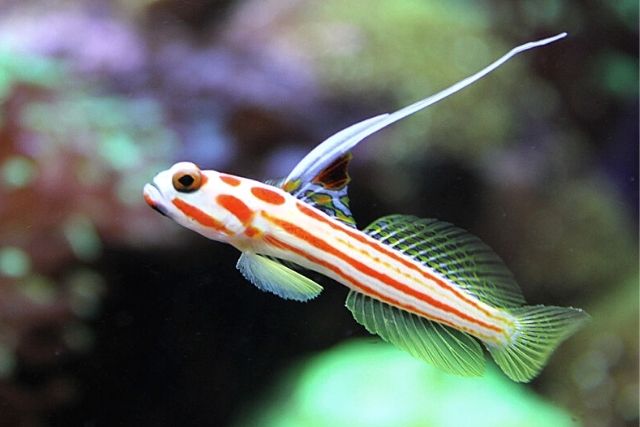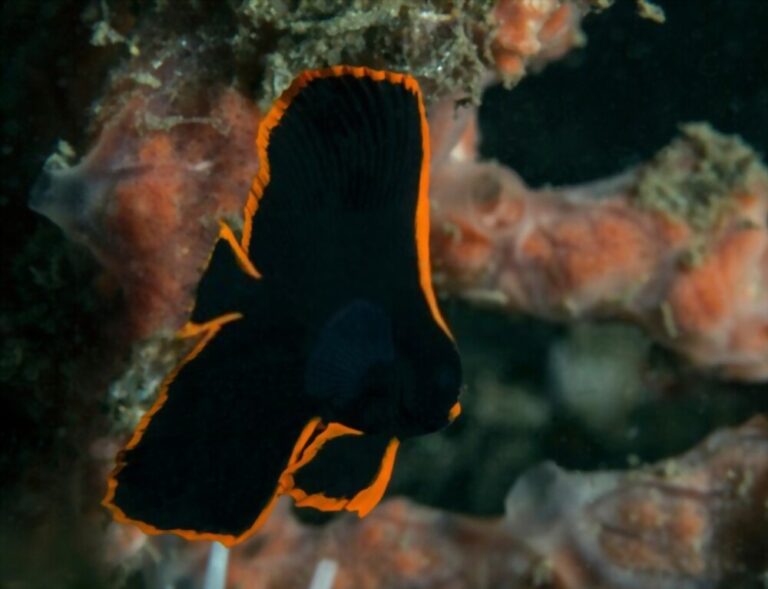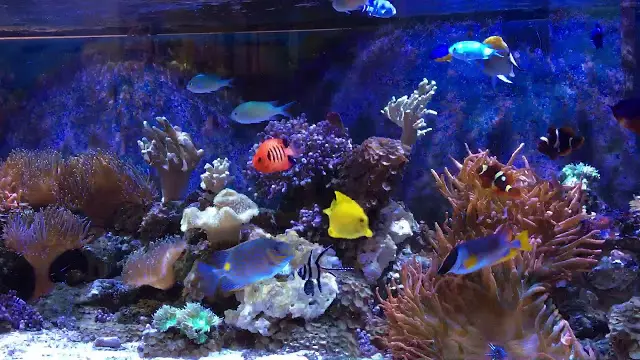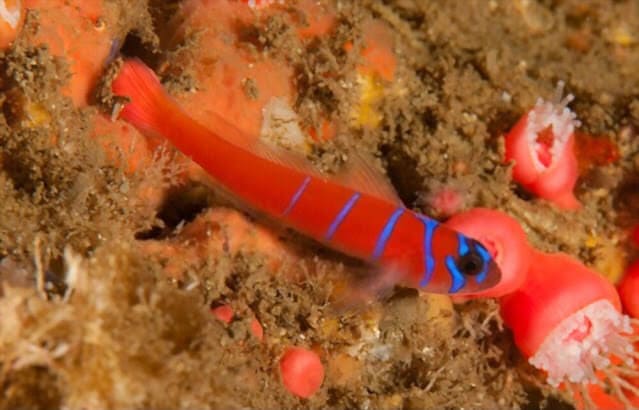Blue Chromis (Care, Size, Lifespan, Diet, Reef Safe, Tank)
Blue Chromis fish belongs to a diverse group of damselfish centered mainly in Bermuda, the coast of Southern Florida, and the Caribbean Sea, where it inhabits the coral reefs and lagoons in shallow waters.
They make up one of the most fishes to be caught massively for the aquarium trade.
Blue Chromis Size
All the damselfish varieties share somewhat common in overall size and appearance. But if we talk about blue chromis fish, the maximum size that they attain is 5.9 inches long and on average 5 to 5.5 inches in length.
Appearance
As far as their physical description is concerned, they have compact and willowy bodies well adapted for shoaling above the reef and for quick escape through the corals if they are being threatened.
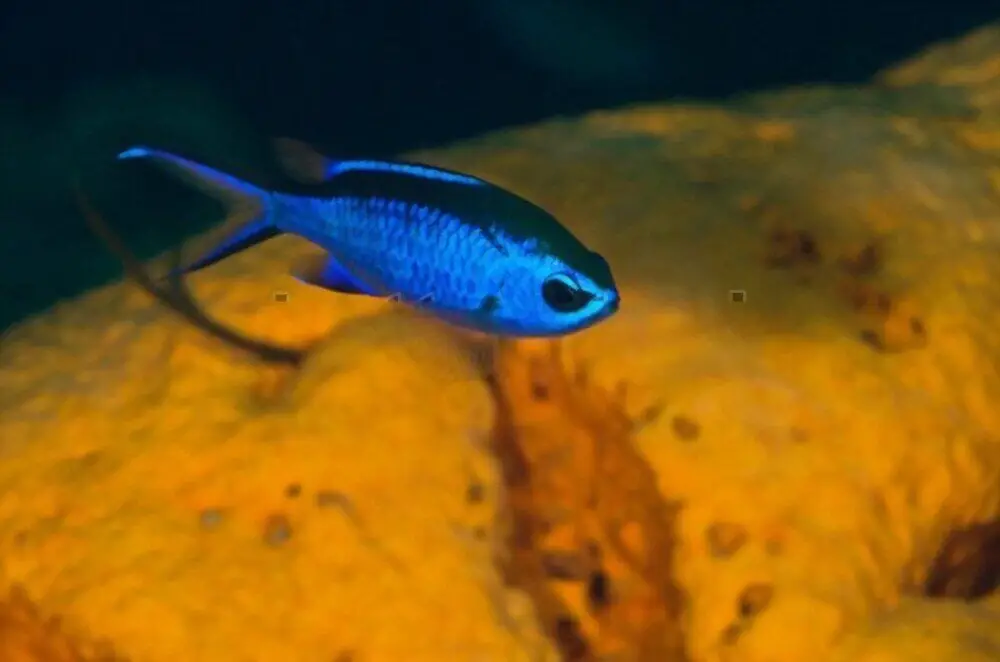
What makes them most fascinating is their intense deep blue coloration and enormously diverged caudal fin, making up a sharp ‘V’ shaped dichotomous fork.
They also have black edging and dorsal and caudal fins, which extend along the fork’s margins. They have darkly shaded along with the eyes, which look very prominent over the body’s deep blue color.
The males are more intensely colored than the females. The males may also exhibit different shades of blue color and are known to have five color morphs.
The most prominent are deep blue and dark grey-blue, while the females are mostly light blue. You can also identify males at the spawning time as they will be darker and have pointed genital papilla.
Blue Chromis Lifespan
Blue Chromis are hardy fish, and they can accompany you for quite a long time if you provide them water conditions and optimal temperature.
Typically they live up to 5 to 6 years in captivity, while some aquarists have successfully kept them for a little over eight years.
Although they are hardy and offer a great deal of resistance to fluctuating water conditions. The levels of ammonia and nitrates can prove to be a silent killer for your vibrant blue reef chromis.
Blue Chromis Reef Safe
They are totally reef safe and naturally inhabit the shallow water reefs, lagoons, and thus commonly named blue reef chromis.
They are not shy and remain very active in the tank almost all the time. Therefore they are preferred for reef aquariums as they add more security to shy and socially reluctant fishes.
Blue Chromis Care
Blue Chromis are very hardy fish and aren’t very difficult to be taken care of. So, they make up excellent fish for the beginners to start their hobby only if they have a little more time to take care of them.
One primary thing to be remembered when you bring these fish home is to maintain them in the quarantine tank before shifting them into the main tank.
However, if your tank already has an established nitrogen cycle and conditions are favorable, then you are good to go with it.
Another caring factor that is of prime importance is the optimal maintenance of water conditions of the tank. Keeping the check on nitrate levels cannot be overlooked as nitrates can quickly deteriorate the water to an extent enough to kill the fish.
For this purpose weekly water change of 10%, a week is recommended by many hobbyists. Bulleted below are the optimal water conditions that the blue chromis need to thrive in the aquarium
- The temperature ranging from 72 to 82 degrees Fahrenheit is considered to be suitable for them. If spawning is intended, then the upper limits of this range need to be maintained.
- These fish perform best in a narrow pH range of 8.1-8.4.
- Carbonate hardness: 8-12 dKH.
- Specific gravity: 1.020-1.025.
Blue Chromis Diet
They are omnivorous fish and feed mostly on zooplankton and other small creatures like mini crustaceans residing on the reef and occasionally on marine herbs. They are diurnal, which means they remain active during the daytime and sleep at night.
How Often To Feed Fish & How Much? A Proper Fish Feeding Guide
Whereas, in the home aquarium, they are effortless to be fed and aren’t picky about the food at all. They gladly accept a variety of meaty as well as commercially prepared high-quality foods.
The best foods include frozen, freeze-dried, or live Mysis shrimp, essential vitamins containing brine shrimp, bloodworms, and krill.
The frozen and freeze-dried food must be thawed first and then finely chopped to be eatable by the fish. The frozen version of meaty foods is preferred over the live ones to minimize the spread of infections. They also readily accept high-quality flakes.
The occasional addition of amphipods and copepods cheer them up. But they do tend to overfeed them and therefore feed them in small amounts.
They do best in a mature tank with its source of planktons, or you are willing to add planktons in your tank. They like to eat frequently, and thus feeding them three times a day is just great.
If your tank holds plenty of the stuff that they can provide, then you can feed them once a day and let them feed the rest on their own.
Blue Chromis Tank Size
The minimum tank size recommended for a single specimen of the blue chromis is 15 gallons if it is the only fish to be maintained in the tank.
Otherwise, 30 gallons would be the minimally suggested tank size for a single specimen. They usually are kept in a shoal of 6, and for that, 60 plus gallons is recommended.
Summing it up, you need to provide them with an ample amount of space. If you can not able to offer it, I am sorry, but I recommend you don’t bring them home.
Tank Setup
As far as the tank setup is concerned, they are reef safe and suitable for reef aquariums as it complies with their natural habitat.
They generally inhabit the mid and top levels of the aquarium, which gives you the edge of adding plenty of live rocks for the formation and setting up of coral polyps.
This rocky and reef formation provides the blue chromis the places for sleeping at night and hiding if they get threatened individually or in school.
An air pump would be necessary to keep the water oxygenated by compelling air into the water. The substrate for the tank has nothing to do with the blue chromis and will depend upon other acquisition needs.
The placement of corals in the tank also plays a role in the selection of the substrate. Mostly, sandy substrate with small crushed gravel is used.
The fish itself doesn’t have any specific lighting demands. However, the live corals may need bright lighting.
Blue Chromis Tank Mates
They are incredibly peaceful community fish and quickly get along with other peaceful fishes and bring out the best of them by promoting interspecies interaction.
That’s why they are for the peaceful tank and not for those tanks hosting some aggressive or semi-aggressive type fishes.
As we have already discussed multiple times, it is best to keep them in a shoal of six individuals. This can be justified that the shoal brings more attraction to the tank as it swims reluctantly in all parts of the aquarium.
Whereas a single blue chromis is prone to become stressed. They might be docile towards other species, but they are known to argue among themselves.
But that’s not a tight head-on, thankfully. Shoal of 6 is perfect. The more individuals you add, the more will be intra-shoal aggression.
So basically, the small and docile species of fish make up the excellent tank mates for the blue reef chromis fish.
Blue Chromis Vs Green Chromis
The main difference between the blue reef chromis and green chromis is the body coloration, yet their general body features are almost the same.
Green Chromis may exhibit coloration from light blue to light or pale green. The second most prominent difference between the two is temperament.
The blue reef chromis are known for interspecies aggression, but the interspecies attack in green chromis is much less. Both the green and blue reef chromis are best kept in a shoal of 6. A shoal of fewer than six individuals may trigger the dominant member’s aggression.
Otherwise, all the behavioral and morphological features of both Chromis varieties are almost the same. The Chromis varieties of damselfish are known to shoal with their kind.
They establish the shoal in the very early stage of their life. But introducing adult individuals to the shoal may not end well for the incoming guy. It is doubtful that the blue reef chromis and green chromis will shoal up.
Last Thought
Over-collection of Blue Chromis for running them into the business threats to the reefs and lagoon systems impose a massive threat to these fish’s natural biodiversity.
However, they are trendy aquarium fish not only for their peaceful nature. But also for their dynamic and friendly qualities, making the tank look active and fascinating.
Because of this quality, they are known to be stress relievers for shy, docile, and timid fishes that keep hidden in fear and stress of the tank’s limited crowded space, unlike of their wild habitat.
